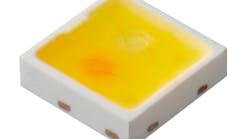For a number of years, interested parties in the US have sought to secure government funding to support research and development in the field of solid-state lighting. The Department of Energy (DOE) already funds a substantial Solid State Lighting program, which supports projects relating to both LEDs and OLEDs, to the tune of $6-7 million in 2004 (up from previous years).
Further progress could be made if the so-called "Next Generation Lighting Initiative" passes into law. Currently, this is a section of the Energy Bill which authorizes the DOE to receive a much larger chunk of funding for solid-state lighting, and for the DOE to work closely with industry to ensure that the fruits of its development program are ultimately turned into products that save energy. Reports commissioned by the DOE describe the extent of energy savings that could result from two different funding scenarios, namely investments at the level of $50 million or $100 million per year.
Unfortunately the Energy Bill has not been passed, but some of the actions of the Next Generation Lighting Initiative are being realized; after soliciting proposals earlier this year, the DOE has selected the Next Generation Lighting Industry Alliance (NGLIA) as its industrial partner.
Formed in March 2003, the NGLIA now has 10 member companies (see below) with an interest in solid-state lighting. The group, administered by the National Electrical Manufacturers Association (NEMA), carries out public advocacy on issues relating to the Next Generation Lighting Initiative and supports efforts to have the Initiative become law.
"Public advocacy essentially means lobbying - we go as a group to government and advocate policies that would be favorable to solid-state lighting," says Dale Work, the current NGLIA Chair and an employee of Philips. "For example, we work to convince congressmen on the appropriations committees that solid-state lighting should be funded as a high priority DOE program." Other Departments, such as those of Commerce, Defense or Homeland Security, could conceivably also be approached, but the focus for now is on the DOE.
Energy Bill
Although the Next Generation Lighting Initiative has been included in the Energy Bill, and appears to be acceptable to all sides, the bad news is that the Energy Bill failed to pass through the US Congress in November 2003 due to political maneuvering. With the pending US election, everything has now ground to a halt.
"Whether or not the Energy Bill gets presented again, substantially unchanged, may depend on the election," says Work. "The Republicans largely crafted the Bill, so if they win the election they are more likely to reintroduce similar legislation in 2005. If the Democrats win, they will probably reject the Republican version and start over."
Although the Initiative makes up less than 1% of the Energy Bill text and has not been highly debated, to be approved it still needs to be attached to a successful Bill. "An alternative is that the NGLIA could work with congress to get the Initiative attached to another Bill," notes Work.
Working with the DOE
Although the DOE has selected the NGLIA as its industrial partner, Work says that some issues remain to be solved before the two groups can finalize their working agreement. "By far the biggest issue is over the intellectual property rights that would be granted to the NGLIA," says Work.
The NGLIA is seeking an exceptional circumstances determination for core technology research funded by the DOE. This determination would be consistent with early Alliance-DOE discussions and with the text of the 2004 core technology solicitation for cooperative agreements. Small businesses and non-profits (such as universities) working under government funding cannot be made to give up IP rights that they might acquire unless exceptional circumstances apply.
"If for example a university received a cooperative agreement for core technology work in solid-state lighting and patented an invention, the exceptional circumstances determination would mean that the university would be obliged to negotiate a fair license to allow the industry partners to use that invention," explains Work. This would not provide royalty-free access - the negotiations would be in good faith for royalty at a reasonable rate, with DOE acting as an arbitrator if necessary. "This is consistent with the DOE's desire that the inventions are embraced by industry and make it into the marketplace, to develop end products that will save energy," says Work.
Industry development
Who exactly would benefit from the exceptional circumstances determination has not yet been decided; the NGLIA position is that all of its members be included; it is also possible that other companies might benefit that have received government money to work in this field. Another key point is that core technology research would be included, but product development would not.
Work says that the NGLIA is deliberately neutral on the question of whether solid-state lighting will reach the market via existing channels, new channels or a combination of the two. "Companies without current involvement in the general lighting market may have an advantage when solid-state lighting takes off, as they will not be constrained by their involvement with older lighting technologies," he says. "Also, no-one is sure at this stage whether solid-state lighting will be a retrofit market or will require brand new form factors."
Membership and NEMA
Although it has only 10 members at present, the NGLIA plans to actively solicit specific companies once its issues with the DOE are resolved. Membership is open to any private, for-profit firm, substantially active in solid-state lighting research, development, infrastructure and manufacturing in the US. This can include foreign companies such as Osram and Philips that have a substantial manufacturing and R&D presence in the US, but excludes those that only have US sales offices. A substantial proportion of NGLIA membership dues go to pay for lobbying activities that represent all the member companies.
The NGLIA's membership administration is handled by NEMA, the National Electrical Manufacturers Association. Although NEMA has a section within its lighting systems division that is devoted to solid-state lighting (see NEMA forms Solid State Lighting section - September 2001), there is no link between this section and the NGLIA. "Our Alliance is formed of companies that are fierce competitors, and we needed a third party organization that could handle administration, such as collecting dues and organizing meetings," says Work. In fact, NEMA's Kyle Pitsor is the best point of contact for companies wishing to join the NGLIA.
The current NGLIA members are:
- 3M
- Cree
- Corning
- Dow Corning
- Eastman Kodak
- General Electric
- GELcore (General Electric Lighting and Emcore)
- Lumileds Lighting (Agilent and Philips)
- Osram Opto Semiconductors
- Philips Electronics North America




